Wetpixel asks the Pros: Wide-angle 1
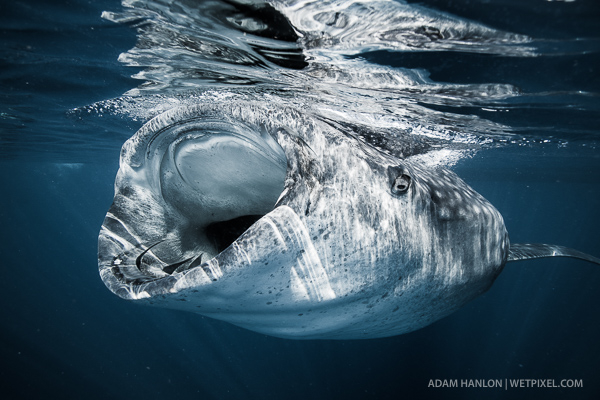
In the second article of our “Ask the Pros” column, we have focused on wide-angle photography techniques. The subject is a huge one, and it was difficult to narrow it down to a manageable number of questions, so it is likely that we will revisit the topic at a later date. We are incredibly lucky to have so many busy professionals willingly sharing their techniques with the Wetpixel community. From us to all of them: Thank You!
- Amanda Cotton, Julian Cohen, Rico Besserdich, Jean Bruneau, David Barrio, Viktor Lyagushkin
- Cristian Dimitrius, David Salvatori, David Fleetham, Berkley White, Allison Vitsky Sallmon and Andy Sallmon, Norbert Wu
- Douglas Seifert, Daniel Botelho, Tony Wu, Franco Banfi, Steve Jones, Alex Tattersall
Amanda Cotton
Amanda Cotton, has never knowingly left home without at least one camera in tow for over 20 years. Specializing in underwater and travel photography, her technical abilities and skills were further mastered through rigorous professional education.
What is you favorite wide-angle lens (please also specify with which camera-more than one answer is allowed :))?
I do love my Tokina 10-17mm when I am shooting on my Nikon D7000, but I really like my 8-16mm Sigma as well, as I am not a fan of the fisheye look. When I am shooting on my D800 I find myself using the 16-35mm most often.
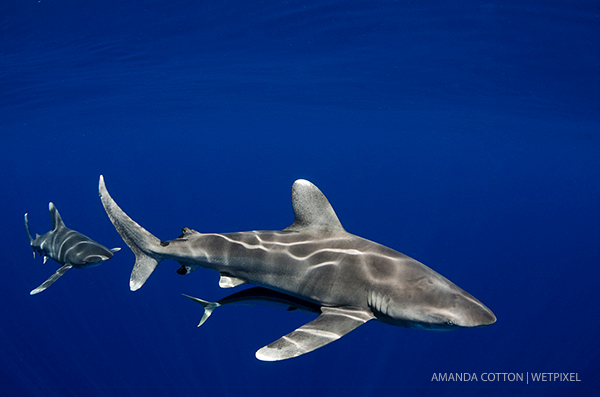
Do you prefer the look of fisheye or rectilinear wide-angle?
I do not like the warped look of fisheye and prefer the look of rectilinear lenses. I think it looks more natural, but underwater photographers can get away with a fisheye look more easily than a topside photographer can.
How do you light wide-angle images or video? What metering pattern do you use? TTL or manual strobe control?
I often times use Matrix metering, because it takes the whole scene into account, but I have to be careful when doing this because I also like to shoot by overexposing the image a 1/3 of a stop. Using matrix metering can cause issues when shooting this way if your camera is metering off the darker area of the frame. I like spot metering best when I am shooting as this allows me to meter off the area I am focused on and is not confined to the center of the frame.
Do you “expose to the right”? Does this technique work/apply for video shooters?
Yes, I typically like to shoot about a 1/3 of a stop overexposed when I am shooting stills. I find for my workflow in post production works best with this starting point.
What are your “go-to” wide-angle exposure settings? How is your camera set up when you get off the boat?
I like to keep my ISO down as low as I can get away with, this usually falls around 200 for a standard sunny day out shooting a mid to shallow reef. I like a dark rich blue to my water so I usually try to keep my shutter speed fast and as close to my sync speed as possible, because more often than not I am using strobes. An aperture of F/8 is usually a great place to start, with my strobe power at either quarter power or half power. Depending on the depth of the dive, available light, and the subject matter I am looking to shoot I will adjust my settings accordingly.
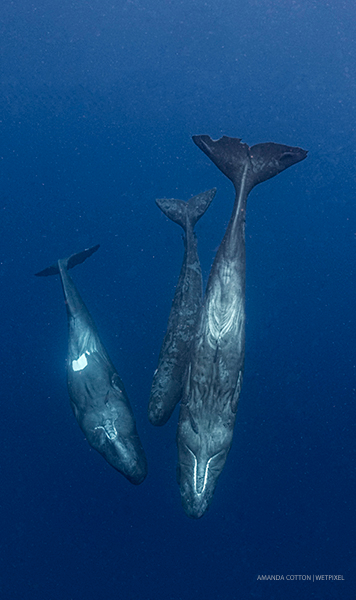
When shooting large animals in the blue (green) do you worry about corner sharpness?
Corner sharpness is still a concern of mine when shooting marine life out in the open ocean. Many of my images are of animals close up and filling a large portion of the frame. Of course this isn’t always the case, but it should remain a concern in case the composition calls for an animal, part of the animal, diver or reef in the distance to be in the corner and is an important part of the final image.
Under what situations would you use shutter priority or aperture priority while shooting wide angle?
I typically shoot on manual, but there are occasions when I will switch to shutter priority to shoot. When I am shooting in an environment where there are significant quick changes in lighting scenarios, such as when you’re shooting sailfish or other fast moving groups of marine animals. In this situation exposure can change quickly and dramatically as you follow the marine life up and down in the water column with your camera.
Julian Cohen
Julian Cohen is constantly traveling and rarely without a camera. He likes flowers and puppies and longs for world peace.
What is you favorite wide-angle lens (please also specify with which camera-more than one answer is allowed :))?
I use a Nikon D4 with a go to lens of Nikonos 13mm Fisheye (Seacam conversion) which I have used for the past year. I also use the Nikon 16mm or the Sigma 15mm. I prefer the Sigma as it focuses much closer than the Nikon.
Do you prefer the look of fisheye or rectilinear wide-angle?
I love the fisheye look. Something about barrel distortion appeals to me.
How do you light wide-angle images or video? What metering pattern do you use? TTL or manual strobe control?
I always shoot fully manual strobes with a spot metering pattern. I don’t think it really matters what metering you use, as long as you know how your camera will expose for the blue when you check the exposure of the water color. I like to play around with my strobe positions, but always keep them well behind the dome, often behind my head, to reduce flare and backscatter.
Do you “expose to the right”? Does this technique work/apply for video shooters?
I tried this when it was first muted, but I couldn’t really see the benefits of it for the way I try to shoot. I like the image on the back of the screen underwater to be as close as possible to the final image, so I expose and light with that in mind.
What are your “go-to” wide-angle exposure settings? How is your camera set up when you get off the boat?
f13 for full frame or f8 for crop sensor to get good depth of field, 1/125, ISO 200…I will generally only adjust the shutter speed depending upon the light conditions.
With the Nikonos I have been experimenting with shooting more wide open. This turtle image was shot at 1/200 and f5 with no strobes and a magic filter
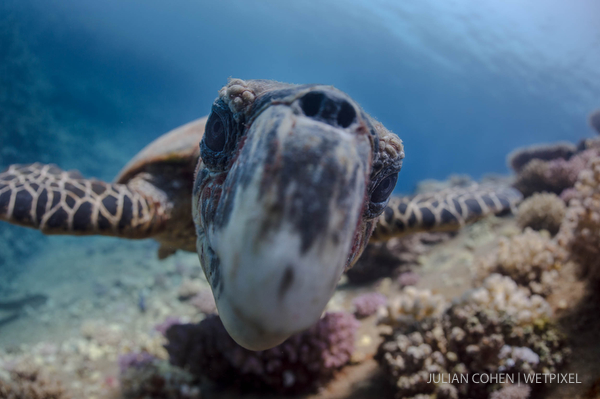
When shooting large animals in the blue (green) do you worry about corner sharpness?
Nope, not unless they are going to fill the frame.
Under what situations would you use shutter priority or aperture priority wile shooting wide angle?
Shutter priority if I am trying to shoot fast moving animals without a strobe such as dolphins. I will then often use exposure EV to adjust the settings depending upon the light conditions. Otherwise I almost always shoot fully manual.
Rico Besserdich
Rico is a professional underwater photographer, artist & journalist. He has been involved in photography since 1978 and became specialized in underwater photography in 2001.
What is you favorite wide-angle lens (please also specify with which camera-more than one answer is allowed :))?
As I am mostly shooting with a crop sensor camera (Canon 7D) my lens of choice is the Canon EF-S 10-22mm, f/3.5 - 4.5.
Do you prefer the look of fisheye or rectilinear wide-angle?
Certainly rectilinear!
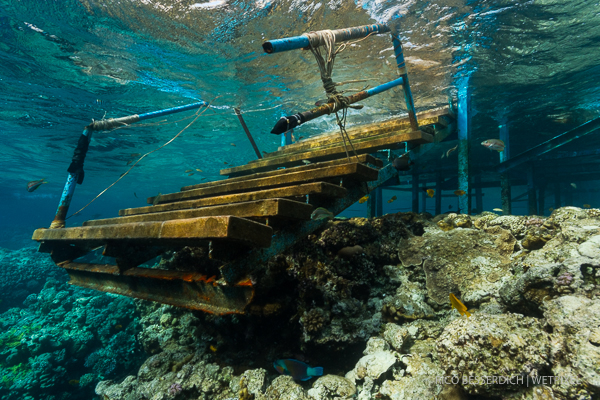
How do you light wide-angle images or video? What metering pattern do you use? TTL or manual strobe control?
I like ambient light wide-angle shots and for those I mostly rely on evaluative (matrix) metering, but sometimes I apply slight exposure corrections. My strobes are always manually controlled and when working with strobes in wide-angle photography I often use the center-weighted metering.
Do you “expose to the right”? Does this technique work/apply for video shooters?
To the right, to the left, to nowhere! It really depends on how I want an image to look like. The “perfect” exposure is anyway the one intended by the photographer and not the one dictated by the histogram. Just my very own opinion of course.

What are your “go-to” wide-angle exposure settings? How is your camera set up when you get off the boat
I actually always trust in the “Martin Edge Setting”: f/8, 1/125s….and be there! Every single dive starts and ends with exactly these settings. But when working “serious” on some wide-angle shots, my camera settings are very often in the ISO 100-200, f/8 - f/13 ( sometimes f/16 ) and 1/60 to 1/160s range. If it is a bit darker (=deeper) I might switch to ISO 400.
When shooting large animals in the blue (green) do you worry about corner sharpness?
Nah, not really.
Under what situations would you use shutter priority or aperture priority wile shooting wide angle?
Hmm…I fear my camera is blocked at the “M” (manual) setting, so I think I prefer the “brain priority” ;-)
Jean Bruneau
Jean has been shooting underwater since 1989, and has been a technical advisor to the underwater housing manufacturer Aquatica since 1990.
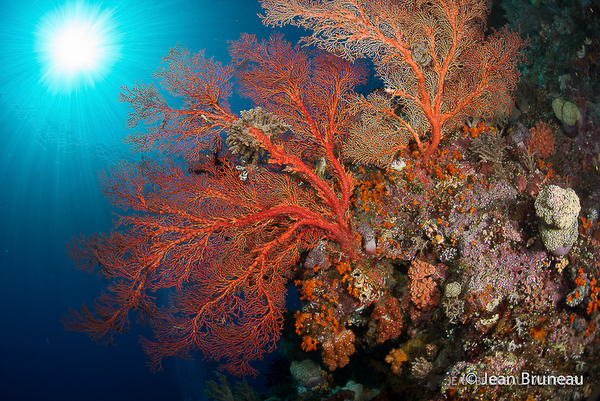
What is you favorite wide-angle lens (please also specify with which camera-more than one answer is allowed :))?
It would have to be the Nikon 14mm rectilinear wide angle for the FX format, and the Sigma 10-20mm when I was shooting DX format, but it is very hard to ignore the fisheye lenses contribution to underwater photography, so while I was a big fan on the Tokina 10-17mm in DX format, I now shoot the Sigma 15mm fisheye on my D800’s cameras, I do find that wide angle and fisheye lenses are story tellers, and therefore need to convey the story by incorporating a foreground, if possible, a middle ground and a background. So careful selection of what is in the front, and the angle used for shooting, especially becomes very important.
Do you prefer the look of fisheye or rectilinear wide-angle?
I prefer the visual rendition of a rectilinear wide angle, but, when you have the right subject, it’s hard to beat the fisheye visual punch! On any given trip, I will try to alternate between the two types of lens, hoping that Murphy’s Law does not interfere too much, which is usually unavoidable at one point or another. The choice become much simpler, if one has the luxury of returning to the same site for a second time.
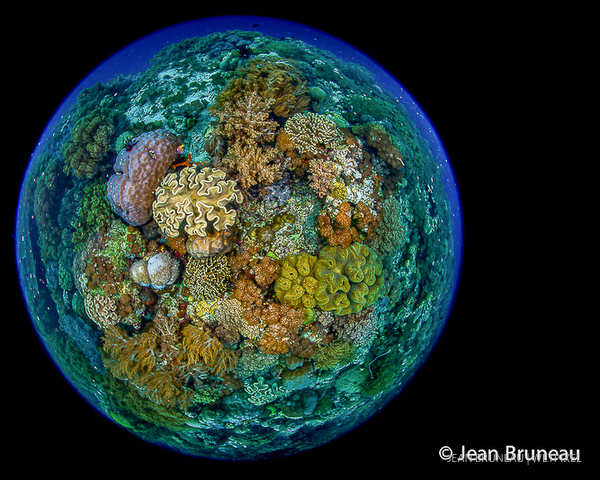
I have a circular fisheye that I have been toying with for the past few years, and it does require a dramatic change of looking at a subject, with this lens, my preferred way of shooting is downward, standing about 2 to 3 meters above the subject. That normally is a major no, no in wide angle photography, but I find that shooting horizontal with a circular fisheye is tantamount to putting a circular black cardboard mask on a regular fisheye lens.
How do you light wide-angle images or video? What metering pattern do you use? TTL or manual strobe control?
I use Matrix metering as a starting reference for the meter, but use the LCD in the back for approval. Lighting is done with two Ikelite DS-160 used with a TTL converter, I find the light output of these have a pleasant warm and soft quality, and the recycling time on these is just incredible compared to AA powered strobes.
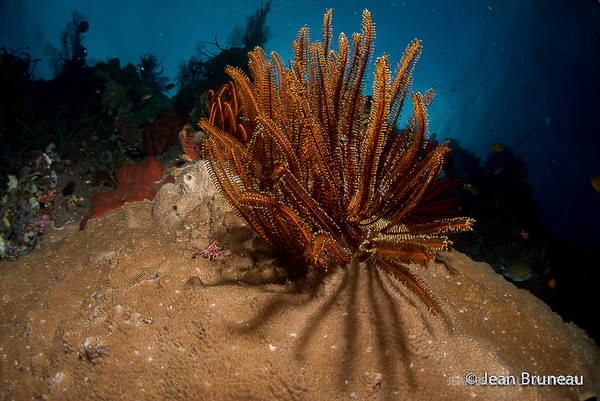
Do you “expose to the right”? Does this technique work/apply for video shooters?
I normally aim for the spot on exposure (that’s the slides film mentality at work here), but if I have to go anywhere with this, it would be conservatively to the right. Can’t say about shooting video as I am a hard core and unrepentant still shooter!
What are your “go-to” wide-angle exposure settings? How is your camera set up when you get off the boat?
When I hit the water, my wide angle/fisheye rig is typically setup with the following parameters. That does not mean, the shots would be good with such parameters, but I know where I am and which way I need to go. There are certainly benefit in establishing a routine pre-flight check list.
Shutter speed: 1/125th
Aperture: f/8
ISO: 100
Flash mode in rear sync.
Main and sub command dial set normally (I use the rear for aperture when shooting macro)
Raw mode and Auto white balance (unless I am shooting available light with a filter)
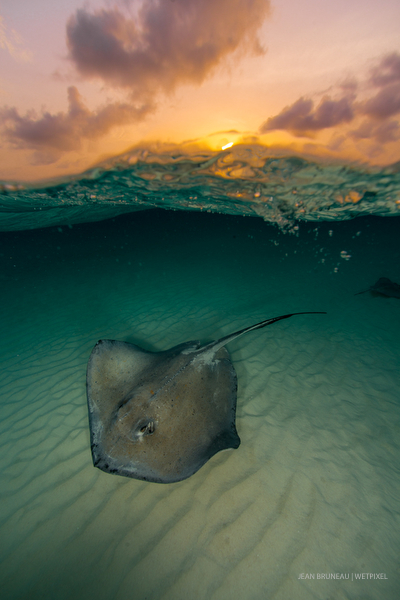
When shooting large animals in the blue (green) do you worry about corner sharpness?
Can’t say I have done much big animals in the blue, but yes, given the inherent optical quality of any dome port when shooting large apertures, I would concern myself with the content of the corners, like trying to avoid including important parts of the animal in the corners.
Under what situations would you use shutter priority or aperture priority while shooting wide angle?
Not really a big user of auto mode underwater, but situation such as available shooting of fast moving animals would likely see me go for shutter priority, can’t really think of any use, in my case, for aperture priority. I’m not being snob, it is just that I find it is much easier/faster to correct things in manual than it is in auto modes.
David Barrio
Over the past nine years, David and his girlfriend and model Luisa have been published in various magazines, covers, and have entered many contests and shootouts. They have been lucky enough to win some of them!
What is you favorite wide-angle lens (please also specify with which camera-more than one answer is allowed :))?
Tokina 10-17 for fisheye and Sigma 10-20 for rectilinear. Both for Nikon DX cameras (D7000 and D7100)
Do you prefer the look of fisheye or rectilinear wide-angle?
I guess most people will answer with a “depends on the motif / image”… and I will also say so. But, to be honest, if I don´t know what I am going to find in the dive, I will take the fisheye with a smaller dome as it is less cumbersome, allows for CFWA and it is more versatile. If it is not a “dive” but a snorkel swim with big animals or a lot of images showing the surface horizon, I will take the Sigma rectilinear as I now tend to prefer straight horizons than “curvy” unreal ones…
How do you light wide-angle images or video? What metering pattern do you use? TTL or manual strobe control?
I very rarely use any metering pattern, but it is point or centered-point to check on the blues-natural light when I do. Nowadays it is just easier to shoot the blue at beginning of the session and adjust from that (depending on where the sun is -in front or behind…- ). For artificial light I always use manual controls on the strobes and, with practice, I more or less know what power I need in most situations. My process when using both natural and artificial light is: expose for the background and then adjust the strobe power. If the resulting combination of speed, aperture and ISO is not compatible with the use of a strobe (for example, speed over the camera´s sync) I change the parameters maintaining the same exposure value.
*Do you “expose to the right”? Does this technique work/apply for video shooters?
I do, unless it is photo sub contest. In any case, cameras are so good now that they allow a lot of exposure-error correction in post process…
What are your “go-to” wide-angle exposure settings? How is your camera set up when you get off the boat?
Strobes on 1/8th, ISO 200, F11-16, V= 1/90ish
When shooting large animals in the blue (green) do you worry about corner sharpness?
Shooting DX cameras, I have never worried about corner sharpness…
Under what situations would you use shutter priority or aperture priority wile shooting wide angle?
Only with fast moving big animals like sharks, dolphins or pilot whales.
Viktor Lyagushkin
Viktor is a National Geographic photographer, official Nikon photographer, Subal Team Pro photographer, winner of many international photo contests and his work has been exhibited in many cities of Europe and America.
What is you favorite wide-angle lens (please also specify with which camera-more than one answer is allowed :))?
I have 2 favorite lenses: 16mm 2.8 fisheye Nikkor and 20mm 1.8 Nikkor with Nikon D4s camera.
Do you prefer the look of fisheye or rectilinear wide-angle?
Fisheye, fisheye and fisheye. Only. There is some difficulty to use it, cause you should control the geometry of the picture and distort the picture so it seems it is not distorted:
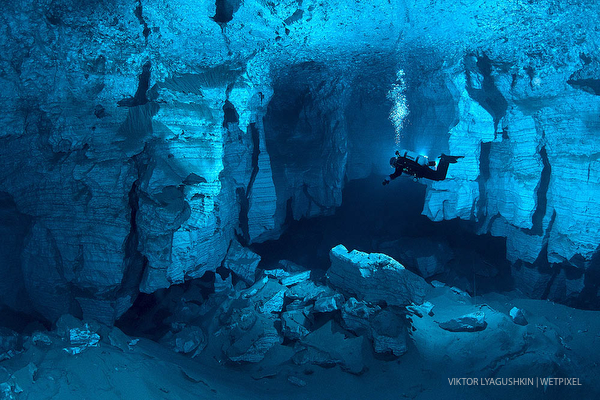
How do you light wide-angle images or video? What metering pattern do you use? TTL or manual strobe control?
Manual strobe and camera control. I think TTL is not for professionals. No one professional uses TTL. TTl do not let you control the scene and you would hardly get the photo you want to have.
Do you “expose to the right”? Does this technique work/apply for video shooters?
I never used it. I even did not know about it. I have enough light on my photo – as much, as I need.
What are your “go-to” wide-angle exposure settings? How is your camera set up when you get off the boat?
1/60 f7.1 and ISO 400, auto WB
When shooting large animals in the blue (green) do you worry about corner sharpness?
No. Because I do not have this issue of corner sharpness.
Under what situations would you use shutter priority or aperture priority wile shooting wide angle?
Underwater I use only manual settings at any situations. As I told you, I prefer to have full control on the scene.
Geo Cloete
Cape Town based Geo Cloete combines a professional life as an architect with a passion for capturing amazing underwater scenes.
What is you favorite wide-angle lens (please also specify with which camera-more than one answer is allowed :))?
At present it’s the Tokina 10-17mm paired with Nikon D300. This is however based on limitations such as funds, dome port owned and using a DX format camera.
Do you prefer the look of fisheye or rectilinear wide-angle?
I have only limited experience with a rectilinear lens. With my current dome port owned, the resulting corners are bad. But would say I do like the look of both from a distortion/perspective point of view. I think the look offered by each differ enough that each valid their use for specific aims.
How do you light wide-angle images or video? What metering pattern do you use? TTL or manual strobe control?
Spot and manual strobe.
Do you “expose to the right”? Does this technique work/apply for video shooters?
In most case not.
What are your “go-to” wide-angle exposure settings? How is your camera set up when you get off the boat?
Really depends on what I can see from the boat. My settings will depend on whether the water is clear or not, weather I am getting into the water with lots of action around or whether it is a reef scene.
When shooting large animals in the blue (green) do you worry about corner sharpness?
Less than in other situation, especially if no part of the animal is in the corners.
Under what situations would you use shutter priority or aperture priority wile shooting wide angle?
I only use manual underwater.
- Amanda Cotton, Julian Cohen, Rico Besserdich, Jean Bruneau, David Barrio, Viktor Lyagushkin
- Cristian Dimitrius, David Salvatori, David Fleetham, Berkley White, Allison Vitsky Sallmon and Andy Sallmon, Norbert Wu
- Douglas Seifert, Daniel Botelho, Tony Wu, Franco Banfi, Steve Jones, Alex Tattersall